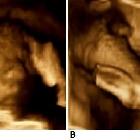twin pregnancy
Twin pregnancies are the most common multifetal pregnancies.
Epidemiology
Multifetal pregnancies account for ~1% of all pregnancies but are seen in much higher numbers in populations where in vitro fertilisation (IVF) is a common practice.
Classification
A twin pregnancy can be broadly categorized into:
- dizygotic twins: 70%
- monozygotic twins: 30%
Dizygotic twins
Also known as fraternal twins resulting from independent fertilization of two ova, and always result in dichorionic - diamniotic pregnancies. This feature alone cannot be used to distinguish dizygotic from monozygotic pregnancies as approximately 20% of monozygotic pregnancies will also be dichorionic-diamniotic (resulting in ~80% of all twin pregnancies being dichorionic-diamniotic). The most reliable sign of dizygosity on ultrasound is documentation of different sex fetuses.
Risk factors for dizygotic pregnancy:
- in vitro fertilisation (IVF): particularly use of ovulation induction agents
- advanced maternal age
- advanced parity
- maternal family history
- ethnicity (e.g. Nigerian 1 in 25 in Nigeria to 1 in 155 in Japan)
Monozygotic twins
Also known as identical twins are due to fertilisation of a single ovum that then separates into two. Unlike dizygotic pregnancy, monozygotic pregnancies do not have maternal age, family history, or ethnic predisposition. The time at which this separation occurs determines the chorionicity and amnionicity of the pregnancy.
Division at:
- 1-4 days (morula) results in dichorionic-diamniotic twins (di-di) (DCDA):
- 20-30% of monozygotic twin pregnancies
- 76% of all twin pregnancies
- 4-8 days (blastocyst) results in monochorionic-diamniotic twins (mono-di) (MCDA):
- 70-75% of monozygotic twin pregnancies
- 30% of all twin pregnancies
- 1-2 weeks results in monochorionic-monoamniotic twins (mono-mono) (MCMA):
- 1-5% of monozygotic twin pregnancies
- 1.5% of all twin pregnancies
- >2 weeks results in conjoined twins:
- <1% of monozygotic twin pregnancies
- <0.3% of all twin pregnancies
Complications
All twin pregnancies have higher fetal and neonatal mortality with overall rates of fetal mortality being 3-6 times that of a singleton pregnancy and neonatal mortality 7 times that of single pregnancies. This is primarily due to a much higher incidence of premature labor and all the sequelae thereof.
The risk of complications depends on the chorionicity, with the prognosis worst for mono-mono and best for di-di:
- di-di: ~10% perinatal mortality
- mono-di: ~20% perinatal mortality
- mono-mono: often >50% perinatal mortality
Monochorionic complications
Despite monochorionic twins amounting to ~20% of twin pregnancies, they account for ~30% of pregnancy-related complications, when all causes are taken into consideration . Monochorionic twin pregnancies share the one placenta and are therefore prone to hemodynamic complications such as:
Amniotic fluid discordance is the most reliable predictor of poorer outcome.
Monoamniotic complications
Monoamniotic twin pregnancies share the one amniotic sac and are prone to entangled cords, as well as all the monochorionic complications (since you cannot be dichorionic-monoamniotic). Conjoined twins occur only in monoamniotic pregnancies.
Radiographic features
Ultrasound assessment of multi-fetal pregnancies
The role of ultrasound is crucial adequate in the monitoring of the pregnancy and planning for delivery. The number of fetuses and their chorionicity and amnionicity must be determined, as well as monitoring for complications and anomalies. Finding the placental sites of umbilical cord insertion are important because marginal and velamentous insertions increase risk .
Determining chorionicity and amnionicity
It is easiest to determine chorionicity and amnionicity in the first trimester.
Dichorionic
- separate gestational sacs with chorion extending between them ( < 10 weeks)
- twin-peak sign or (lambda sign) ( > 10 weeks): thick intertwin membrane, with more than two layers
- separate placental masses (note, however, that most dichorionic pregnancies have placental masses that abut each other
- however, the thickness is however subjective and becomes progressively more difficult to assess (98% accuracy in the first trimester vs 83% later)
- twins may be of different genders
Monochorionic diamniotic
- single gestational sac
- two yolk sacs
- T sign: thin intertwin membrane
- single placental mass (note, however, that most dichorionic pregnancies have placental masses that abut each other and can be often mistaken for single placenta, especially in the third trimester)
Monoamniotic
- no intertwin membrane
- usually one yolk sac
- entangled cords common
Siehe auch:
- gestational sac
- Chorion
- first trimester
- acardiac twin
- Dottersack
- monochorionic twin pregnancy
- amniotic fluid discordance
- Siamesische Zwillinge
- demise of co-twin
- monochorionic - diamniotic twins
- inter twin membrane
- monochoriale-monoamniote Zwillingsschwangerschaft
- monozygotic twins
- twin embolisation syndrome
- dichorionic - diamniotic
- twin reversed arterial perfusion sequence
- dizygotic twins
- twin-peak sign
- t sign
- entangled cords
- twin-twin transfusion
- gestational sacs
- amniotic sac
und weiter:
- bilobed placenta
- dichorionic diamniotic twin pregnancy
- marginal cord insertion
- velamentous cord insertion
- singuläre Nabelschnurarterie (sNSA)
- cephalic index
- accessory placental lobe
- fetal cardiomegaly
- demise of a twin
- fetal akinesia / hypokinesia sequence
- two vessel cord
- fetal biometric discordance
- dizygotic twin pregnancy
- dichorionic twin pregnancy
- placental fusion

 Assoziationen und Differentialdiagnosen zu Zwillingsschwangerschaft:
Assoziationen und Differentialdiagnosen zu Zwillingsschwangerschaft:




